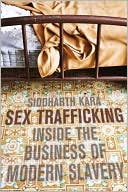Sex Trafficking: Inside the Business of Modern Slavery
Search in google:
Every year, hundreds of thousands of women and children are abducted, deceived, seduced, or sold into forced prostitution, coerced to service hundreds if not thousands of men before being discarded. These trafficked sex slaves form the backbone of one of the world's most profitable illicit enterprises and generate huge profits for their exploiters, for unlike narcotics, which must be grown, harvested, refined, and packaged, sex slaves require no such "processing," and can be repeatedly "consumed."Kara first encountered the horrors of slavery in a Bosnian refugee camp in 1995. Subsequently, in the first journey of its kind, he traveled across four continents to investigate these crimes and take stock of their devastating human toll. Kara made several trips to India, Nepal, Burma, Thailand, Laos, Vietnam, the United Kingdom, Italy, the Netherlands, Denmark, Albania, Moldova, Mexico, and the United States. He witnessed firsthand the sale of human beings into slavery, interviewed over four hundred slaves, and confronted some of those who trafficked and exploited them.In this book, Kara provides a riveting account of his journey into this unconscionable industry, sharing the moving stories of its victims and revealing the shocking conditions of their exploitation. He draws on his background in finance, economics, and law to provide the first ever business analysis of contemporary slavery worldwide, focusing on its most profitable and barbaric form: sex trafficking. Kara describes the local factors and global economic forces that gave rise to this and other forms of modern slavery over the past two decades and quantifies, for the first time, the size, growth, andprofitability of each industry. Finally, he identifies the sectors of the sex trafficking industry that would be hardest hit by specifically designed interventions and recommends the specific legal, tactical, and policy measures that would target these vulnerable sectors and help to abolish this form of slavery, once and for all.The author will donate a portion of the proceeds of this book to the anti-slavery organization, Free the Slaves. Publishers Weekly Kara, a former investment banker and executive, uses theoretical economics and business analysis to propose measures that could eradicate sex trafficking by undermining the profitability of the illegal activities associated with the crime. At considerable personal risk and expense-he is nearly attacked by a gang of pimps in Mumbai-the author penetrates seedy underworlds and forced labor markets to meet the women and children in the "dungeon of human disgrace" in Asia, Europe and the U.S. He highlights ubiquitous and disturbing trends-the heavy involvement of law enforcement agencies and personnel in trafficking and slavery-but this book's intentions suffers from Kara's self-professed "rudimentary" economic analysis, which often borders on the offensive (a theoretical calculation of the lifetime value of a sex slave) and an unscientific, ad hoc research model. While the evidence indicates the urgent need for action-a woman or child is trafficked for sexual exploitation every 60 seconds-Kara's economic approach fails to shed new light on the human cost of sex slavery and seems at the best of times beside the point, although the detailed statistical information he compiles-on everything from the costs of running a brothel in Queens, N.Y., to massage parlor and bonded labor economics worldwide-is a resource for researchers in the field. (Jan.)Copyright © Reed Business Information, a division of Reed Elsevier Inc. All rights reserved.
PrefaceAcknowledgments1. Sex Trafficking: An Overview2. India and Nepal3. Italy and Western Europe4. Moldova and the Former Soviet Union5. Albania and the Balkans6. Thailand and the Mekong Subregion7. The United States8. A Framework for Abolition: Risk and DemandAppendix A: Selected Tables and NotesAppendix B: Contemporary Slavery EconomicsAppendix C: Selected Human Development StatisticsNotesWorks CitedIndex








